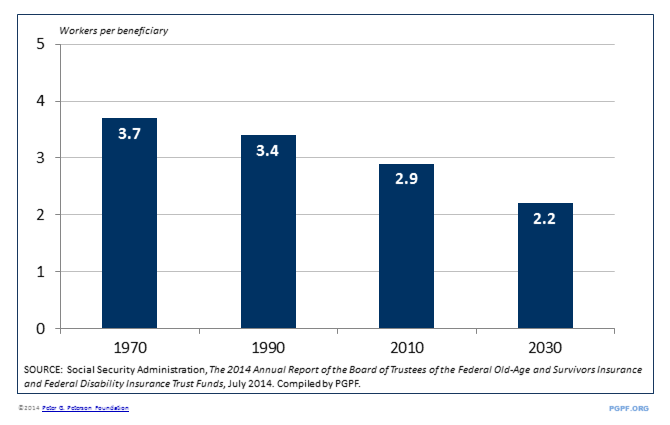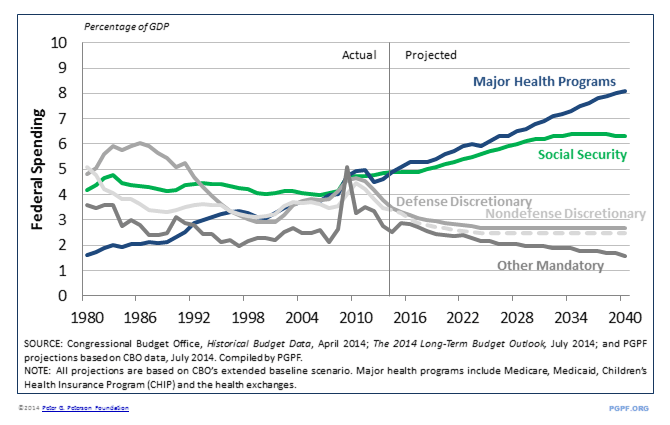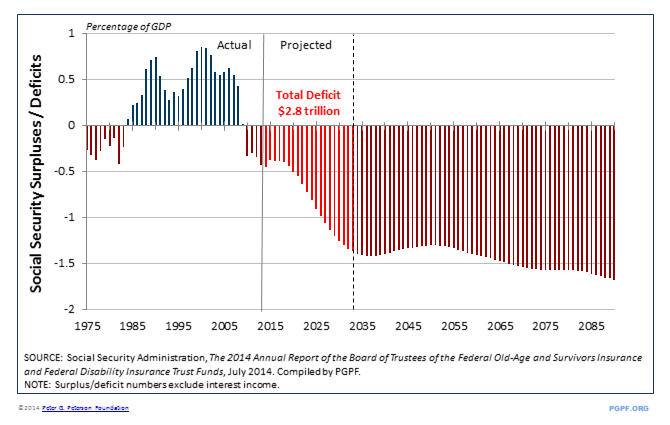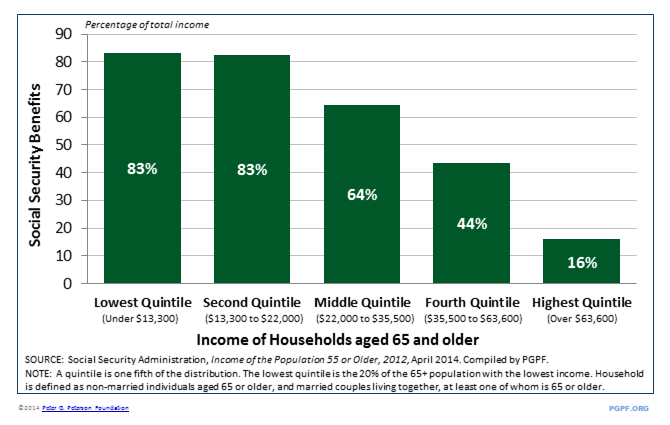You are here
Social Security Faces Major Financial Challenges
Social Security currently provides benefits to 59 million Americans, including retired workers, disabled workers, and their spouses and survivors. As the population ages and the large baby boom generation enters retirement, the number of people receiving benefits is expected to climb to 88 million by 2033.
Social Security faces major financial challenges. In their annual report, which was released Monday, the Trustees warn that without legislative action:
- The combined Old Age and Survivors’ Insurance and Disability Insurance Trust Funds, commonly referred to as the "Social Security Trust Funds," will be fully depleted by 2033.
- 100% of the program’s beneficiaries will face benefit cuts of 23 percent in 2033.
- Retirees with average pre-retirement earnings will face a benefit cut of $5,750 per year in real (inflation-adjusted) benefits in 2033.1
Immediate action is needed to preserve the Disability Trust Fund. In two years, the Trustees expect that the Disability Trust Fund will be fully exhausted. Without legislative action, they estimate that all of the 11 million disabled Americans and their families will face benefit cuts of 19 percent in 2016.
What is Social Security?
Social Security is the largest social insurance program in the United States. Almost every American worker pays a dedicated payroll tax, which entitles them to benefits when they retire or become disabled. The program also provides benefits to insured workers’ spouses and survivors.
Social Security currently serves approximately 59 million people, including 42 million retired workers, 11 million disabled, 6 million survivors, and their families. As the baby boomers retire and life expectancy increases, the number of people enrolled in the program will increase sharply over the next several decades. By 2033, total enrollment is projected to reach 88 million, 50 percent more than the number enrolled in 2014. As the number of retirees grows rapidly, there will be fewer workers remaining to pay taxes to support each Social Security beneficiary.
As the population ages, fewer workers will be paying taxes to support each Social Security beneficiary

Social Security is currently the largest single program in the federal budget. In 2013, Social Security comprised almost a quarter of the federal budget. Over the next twenty-five years, as enrollment rises, the cost of Social Security will continue to grow, second only to major health programs, such as Medicare and Medicaid. The Congressional Budget Office estimates that Social Security spending will rise by 29 percent over the next 25 years (as a percent of GDP).
Social Security spending will rise over the next 25 years, growing second only to major health programs

Social Security is running a cash deficit
Social Security has been facing financial shortfalls in recent years. Between 1984 and 2009, Social Security’s income exceeded its benefit payments and cost of operations, resulting in large fund balances. However, since 2010, Social Security has been paying out more in benefits than it collects in payroll taxes and other receipts. In 2014, this cash deficit, which excludes interest, will amount to $80 billion, and that deficit is projected to grow sharply in the decades to come.2 In order to fund these shortfalls, the Treasury is required to borrow additional funds from the public.
Social Security will run a cumulative cash deficit of $2.8 trillion between now and 2033

Unless current law is changed, the Trustees estimate that the combined Social Security Trust Funds will be depleted by 2033. Once that happens, Social Security will lack the resources to pay out full benefits. As a result, the Trustees project that benefits for 88 million Americans (including 67 million retirees) would have to be cut by 23 percent compared to what they would receive if the program was adequately financed. For a retiree who has average pre-retirement earnings, annual Social Security benefits would be cut automatically by about $5,750 in today’s dollars.3 This cut would disproportionately affect vulnerable and low-income populations, who rely significantly on Social Security.
The Disability Insurance Trust Fund
The outlook for the Disability Insurance (DI) Trust Fund is even more dire. The Trustees urge policy makers to take "legislative action as soon as possible to address the disability insurance program’s financial imbalance."
The DI Trust Fund has been running cash deficits since 2008 and its balances will be depleted by the end of 2016 — two years from now. Once that happens, the government would have to cut the program’s spending to match its incoming revenues. The Trustees’ project that this will require cutting benefits by 19 percent for 11 million disabled Americans and their families, reducing annual benefits by about $2,580, on average.4
The Disability Insurance Trust Fund will run out of funds by 2016

Solutions for Social Security Exist
Many policy solutions exist for improving the financial outlook of Social Security. In 2010, the Congressional Budget Office published a report with thirty options for improving the long-term stability of the program. These options included reducing annual cost of living adjustments, increasing payroll taxes, reducing initial benefits, and raising the retirement age.
For their basic financial planning, the American people need to know what benefits they will receive in retirement. If benefit levels are to be cut, people should be given ample warning so they have time to adjust their saving and retirement plans to make up for any losses. If taxes are to be raised, people need to incorporate those changes into their plans.
Importantly, if policymakers act sooner rather than later, they will have more and better options, which can be gradually implemented to reduce their impact. Conversely, every year of delay and inaction limits options and makes reform more difficult.
Knowing how policymakers will resolve the fiscal imbalances in the Social Security program is especially important for low-income people who rely so heavily on the program. In 2012, Social Security provided 80 percent of the retirement income to the bottom two quintiles of retirement beneficiaries (those with $22,000 or less of total income).
Low-income seniors rely on Social Security benefits for a major share of their retirement income

The math is simple and the consequences of inaction are clear. Policymakers should seize the opportunity to stabilize and strengthen the safety net for generations to come. As the Trustees state, "With informed discussion, creative thinking and timely legislative action, Social Security can continue to protect future generations."
For more information about trust funds, please see the following Budget Explainer:
What Are Federal Trust Funds?
Additional Resources:
- 2014 Social Security Trustees Report
- The Social Security Commission Act of 2014
- CBO’s Options for Reducing the Deficit: 2014-2023
- CBO’s Policy Options for Disability Insurance
- CBO’s Social Security Policy options
1A retiree with average pre-retirement earnings is someone whose earnings, over the course of their career, average to 100% of the national average wage index. (Back to citation)
2Social Security also receives interest income from its Treasury securities, but this income is offset by an interest cost to the Treasury, making the flows net to zero from the perspective of the overall federal budget. (Back to citation)
3A retiree with average pre-retirement earnings is someone whose earnings, over the course of their career, is equal to average to 100% of the national average wage index. If Social Security were fully financed, it would provide these retirees with $24,350 in inflation-adjusted benefits in 2033. With a 23% cut in benefits, annual benefits would be reduced to about $18,750. (Back to citation)
4Total disability benefit payments for 2016 are projected to be $152.1 billion, distributed to 11.2 million beneficiaries. On average, disability beneficiaries, are projected to receive $13,580 in annual benefits in 2016. With a 19% cut in benefits, these annual benefits would be reduced by $2,580. (Back to citation)
